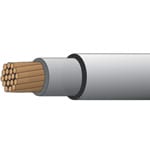Most residential homes are fed with single-phase power (sometimes called split-phase.) The power company runs three wires into the home which comprises of two hot wires and a neutral wire. The neutral is actually a center-tapped feed off the transformer. Voltage measured across both hot wires is 240 VAC. Voltage measured from any hot to neutral is 120 VAC (split-phase). So, a regular 120 VAC circuit is fed with one hot and the neutral (split-phase). A dryer or oven is fed with both hots which provides 240 VAC (single or full-phase). Some people mistakenly believe that a 240 VAC circuit is "two-phase," but they are wrong; it's actually the full phase of a single-phase circuit whereas the 120 VAC feeds are half-phase (split-phase).
Most commercial buildings are wired with three-phase power. Three phase power has three hot wires with each being 120 degrees out of phase with each other. Three-phase power can be more efficient than single-phase power in certain applications. Three-phase motors, for example, are much more powerful (or efficient) than their single-phase counterparts. And three-phase motors are cheaper because they are less complex and do not require starting capacitors. Here is a good analogy which should help you visualize the differences between the two: Using a single-phase supply is like one strong man pushing a car uphill. At some point, the work is beyond what that one man can do; whereas a three-phase supply is like having three equally strong men each pushing the car in a relay system one after another. The end result is that each man is doing 1/3 the work of the one strong man so, together, the three of them push the car further. Or, you can think of it like this: In the U.S., our power is generated at 60 Hz. So, a single-phase circuit's sine wave will swing +/- at a rate of 60 times per second. Think of it as 60 "pulses" or "pushes" of work per second. A three-phase circuit combines three single-phase circuits (each 120 degrees out of sync with the other) so in the same one second period of time you've got three "pulses" or "pushes" ... or three times the work!
To determine whether you have three-phase or single-phase power, simply measure the voltage between two hots or a hot and ground. You're most likely to encounter a three-phase circuit that shows 120 VAC between any hot and ground, and 208 VAC between any two hots. A single-phase circuit will show 120 VAC between a hot and ground, and 240 VAC between any two hots.
What is the difference between Three Phase vs Single Phase?

